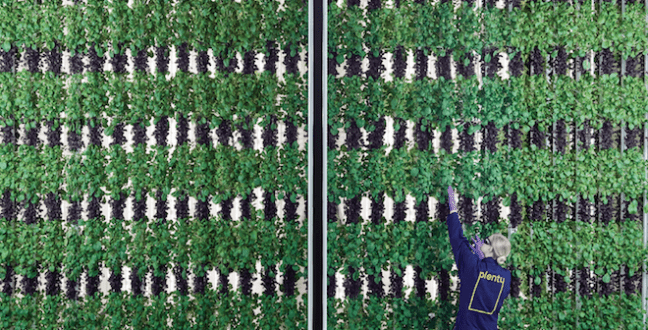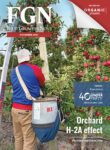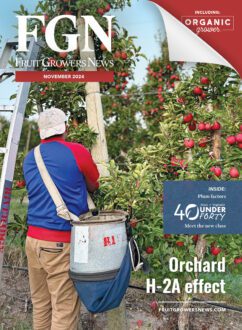
Dec 9, 2020Driscoll’s, Plenty research vertical farming for strawberries
Strawberry growers know about raised beds – but vertical farms are something else entirely.
Berry industry heavyweight Driscoll’s and vertical farming innovator Plenty in October announced a collaboration on strawberries – marrying Driscoll’s proprietary genetics and berry expertise to Plenty’s advanced indoor farming technology and plant science expertise.
Driscoll’s strawberries will initially be grown and developed in Plenty’s Laramie, Wyoming, farm, “the largest privately-owned vertical farm research and development center in the world,” according to a news release. Driscoll’s said the project would make use of the benefits of controlled growing environment, while “creating expansion into regions that have historically been difficult to serve.
So, how does one grow strawberries vertically? Mike Schwieterman, head of flavor and nutrition at Plenty, who has a Ph.D. in plant molecular and cellular biology from the University of Florida, will be one of the leaders of the project with Driscoll’s. He recently participated in a question-and-answer exchange with Fruit Growers News.
Fruit Growers News: What season or seasons, or particular market would be best served by indoor strawberry growers?
 Mike Schwieterman: Indoor strawberry farms can grow strawberries regardless of season or climate. Once you take seasonality and climate out of the equation, indoor growers have a unique advantage – neither snow, rain, heat or gloom of night are barriers to providing delicious fresh fruits and vegetables to
Mike Schwieterman: Indoor strawberry farms can grow strawberries regardless of season or climate. Once you take seasonality and climate out of the equation, indoor growers have a unique advantage – neither snow, rain, heat or gloom of night are barriers to providing delicious fresh fruits and vegetables to
local markets. Currently, strawberries grown outdoors need very specific climates to thrive. Bringing them indoors allows us to place a farm just about anywhere and deliver fresh strawberries locally.
Today, a strawberry that leaves a California field can travel upward of 3,000 miles before it reaches a wholesale market on the East Coast. This cross-country trip takes a toll on flavor, shelf life and nutrition. By building indoor farms that can produce continuously next door to the communities and markets we serve, we can get strawberries onto shelves and onto taste buds almost directly after harvest – ensuring the sort of freshness that few consumers have had the opportunity to experience.
FGN: Wendy’s started using indoor tomatoes a few years back. Is controlled environment agriculture mainstream, or acceptable to most customers at this point?
MS: There’s definitely growing demand and excitement from customers for pesticide-free, flavor-forward food. Retailers are excited about innovative agriculture that can deliver delicious, fresh food consistently. Our new partnerships with both Albertsons (leafy greens) and Driscoll’s (strawberries) is a good example of the scale of this momentum.
An increasing emphasis from all sectors on resilient and sustainable food systems are also drivers here. The COVID-19 pandemic and West Coast wildfires uncovered the fragility of traditionally complex and convoluted agricultural supply chains. Grocery store shelves stood empty and crops couldn’t make it out of the field. Climate change is also impacting agriculture. Seventy percent of crop loss in 2019 was due to extreme weather. Rising trends in aridity and unpredictable weather threaten food supplies globally. Indoor farms like Plenty are resilient to climatic variation, have flexible production models, and streamline supply chains.
FGN: It would seem to me that the strawberry plant, being smaller, would be easier to farm indoors than, say, blueberries. Can the plants just nestle in vertical media, similar to how greens are grown indoors?
MS: We do anchor our strawberries in vertical media, similar to our greens. We believe that most crops, blueberries included, can be produced indoors. To grow more crops indoors, both cultivars and varieties will need to be tested to see which ones thrive in these types of environments. There are many more varieties than what consumers buy on shelves. Growing indoors gives us the opportunity to try varieties that consumers haven’t had the chance to experience. This is a continued focus of our R&D efforts.
While the size of strawberry plants, like leafy greens, make them ideal candidates for indoor farming, they do require a precise and dynamic environment. The long production cycles, complex crop development and environment interactions, continuous harvesting, and requirements for propagation present many challenges when compared to the fast growing, seedborn leafy greens.
FGN: Who at Plenty is heading up this project?
MS: We have an amazing cross-functional team working on strawberries spanning our Laramie, Wyoming, and south San Francisco, California, facilities led by myself along with Dan Schreiber and Paul Kreiner. I grew up on my family farm and pursued an interest in plant sciences and a passion for flavor in my graduate studies at the University of Florida before joining the berry industry. At Plenty, I can combine my industry and technical experience to drive flavor in the lab and the farm to great effect.
FGN: Would it be safe to call this hydroponic growing?
MS: Definitely!
FGN: Many indoor greens and tomato growers I’ve interviewed make claims about being able to grow for a particular taste. Are the growing conditions for the strawberries part of what you’re researching, and what is the potential there for strawberry taste?
MS: We have a thorough understanding of the chemistry and biology underlying strawberry flavor, which means we can optimize for specific profiles with precision in a controlled environment. Our research and development pipeline includes screening, optimizing environmental growing conditions, nutritional profiles, and an intensive focus on lighting. This research will ultimately provide the recipe and farm design to grow a sweet and intensely flavorful strawberry. We think this product will truly differentiate from other offerings in the produce aisle.
FGN: What are some characteristics you as a team would be looking for in a new strawberry variety?
MS: We see a divide between consumer experience and expectations when it comes to strawberries. Our research program screens varieties for flavor first as well as key components of yield and plant performance. The diversity of strawberry genetics available presents a great opportunity to deliver many strawberry products to consumers, such as classic sweet and tangy, small berries with wild and exotic flavors, or novel colored fruit. We also put an emphasis on varieties that are efficient to grow, maintain, and harvest. With our protected growing environment, we place extra emphasis on flavor, texture and color over varieties bred for tolerance of disease and other field stress.
FGN: Can you explain how the development process will work – would it be comparable to field trials?
MS: Our development process does have similarities to field trials but also follows many technology development principles. We optimize production for desired phenotypes by manipulating the environment, management, and the production system. We gain huge advantages with the level of control we have over our environment and the accelerated pace facilitated by a continuous production. Right now, our focus is on continually improving and driving flavor and quality.
— Stephen Kloosterman, associate editor














